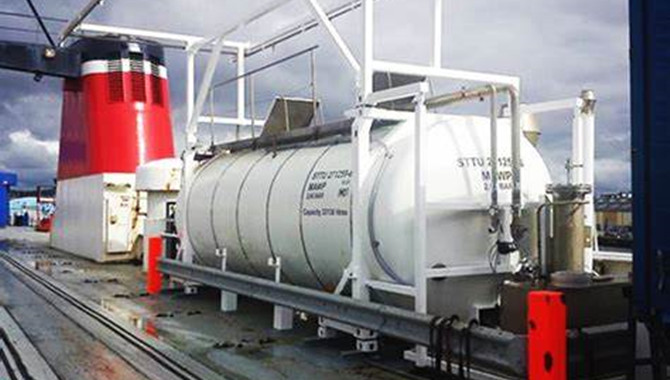Among the mix of possible alternative fuels available for marine use, methanol—a chemical building block for hundreds of everyday products—is fast emerging as an attractive option for shipping companies looking to reduce their carbon footprint and meet sector-wide emissions targets.
In November 2020, the International Maritime Organization announced that it aims to reduce absolute shipping emissions by at least 50% from 2008 levels by 2050, and to attempt to eliminate them completely thereafter.
Shipping's decarbonization goals need immediate action if they are to be successful, but choosing a winner from among the various alternative fuels that are currently available remains difficult. Each fuel—whether that's electric batteries, hydrogen, ammonia, or methanol—comes with its own set of advantages and limitations, with no one-size-fits-all approach. LNG and biofuels are other alternative fuels being considered by the shipping industry to meet the IMO greenhouse gas emissions targets.
The future therefore heralds a mix of fuel options, said Saunak Rai, general manager of FueLNG—a joint venture between Keppel Offshore & Marine Ltd. and Shell Eastern Petroleum (Pte) Ltd—at the 12th International Fujairah Bunkering & Fuel Oil Virtual Forum, or FUJCON, 2021.
Methanol as an option in dual-fuel vessels
A range of reliable dual-fuel vessel engines are already available in the market and give operators the flexibility they need to react to changing environmental regulations and fuel availability. Dual-fuel engines allow operators to mix green methanol with more readily available methanol produced from residual industry gases or from natural gas. This means that vessel owners can gradually transition as prices for renewable methanol come down, and infrastructure and supply are ready for use, making it safer for companies to invest in methanol engines without the risk of later suffering a fuel shortage, according to MAN Energy Solutions.
Methanol offers significant emissions savings as a bunker fuel and could carve out a sizable niche as a shipping fuel despite demands from other industrial sectors, Stuart McCall, director for business development at Canadian methanol producer Methanex, told S&P Global Platts in a recent interview.
Methanol's allure as a marine fuel is gaining prominence in shipping's decarbonization drive and it is set to play a “sizable role” in the global bunker fuel mix by 2050, industry sources told Platts. But its short- to medium-term prospects have also received a boost after A.P. Moller-Maersk announced plans to have eight large ocean-going container vessels capable of being operated on carbon neutral methanol, said Chris Chatterton, chief operating officer at the Methanol Institute.
“This is a very strategic investment in a highly innovative, proven technology which will deliver significant net GHG reductions and which will require a corresponding build out of methanol bunkering capacity in select ports,” Chatterton said in an interview.
Furthermore, Proman Stena Bulk's first methanol dual-fuelled medium-range tanker, the 49,900 dwt Stena Pro Patria, has been transferred to water for further construction. It is set to be delivered to Proman Stena Bulk in the first quarter 2022. The Stena Pro Patria is the first of six methanol-powered tankers ordered by Proman Stena Bulk and built by Guangzhou Shipyard International. The other five are slated for delivery by end-2023.
Demand for fuel price transparency
In response to growing market demand for methanol in shipping, Platts has developed new assessments of methanol bunker fuel prices, reflecting the value of methanol used as a marine fuel at the ports of Rotterdam, effective Sept. 27, as well as Singapore and Houston, effective Oct. 25.
Platts assesses methanol bunker fuel at a differential from its daily methanol spot assessments in Singapore, Rotterdam and Houston, calculated in $/mt. The methanol bunker fuel price includes the logistics costs from the terminal to the barge or truck, and charges for delivery direct to the receiving vessel. As trading activity emerges in this nascent market, Platts assessment approach will evolve accordingly and may take into consideration other local methanol bunkering hubs.
Additionally, Platts publishes methanol bunker fuel calculations converted to LNG and oil energy content equivalents, enabling comparison with other marine fuels, using the following factors to convert the methanol price from metric tons.
Alongside the launch of methanol bunker fuel assessments, Platts has introduced daily cost comparisons for alternative marine fuels, reflecting the price per fuel calorific value comparison of methanol bunker fuel, LNG bunker fuel, marine fuel oil and marine gasoil.
The area of clean and alternative bunker fuels is proving to be dynamic and fluid. Tracking existing value chains and developments in terms of specifications, related carbon prices and trading liquidity will be essential in order to ensure transparency as the market evolves.
Source: Platts
The opinions expressed herein are the author's and not necessarily those of The Xinde Marine News.
Please Contact Us at:
media@xindemarine.com


 Ningbo Containerized Freight Index Weekly Commentar
Ningbo Containerized Freight Index Weekly Commentar  Ningbo Containerized Freight Index Weekly Commentar
Ningbo Containerized Freight Index Weekly Commentar  Ningbo Containerized Freight Index Weekly Commentar
Ningbo Containerized Freight Index Weekly Commentar  BIMCO Shipping Number of the Week: Bulker newbuildi
BIMCO Shipping Number of the Week: Bulker newbuildi  Ningbo Containerized Freight Index Weekly Commentar
Ningbo Containerized Freight Index Weekly Commentar  Ningbo Containerized Freight Index Weekly Commentar
Ningbo Containerized Freight Index Weekly Commentar